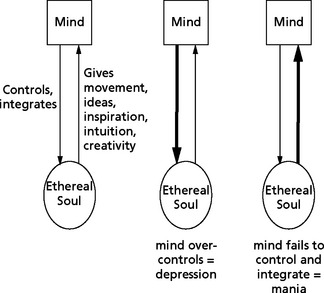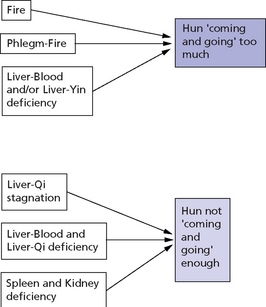 MENTAL—EMOTIONAL SYMPTOMS
MENTAL—EMOTIONAL SYMPTOMS
WHEN WE ASK
If the emotional condition is not the presenting problem, I generally ask about a patient’s emotional life towards the end of the consultation to try to find the cause of the disease. In many cases, the emotional state of the patient is the main presenting problem; for example, patients may come to us because they are depressed or anxious. In other cases, the emotional state of the patient is the underlying cause of physical symptoms; for example, a patient may complain of tiredness and digestive symptoms when frustration and resentment may be the cause of the condition.
HOW WE ASK
As mentioned above, we must use great sensitivity when asking patients about their emotions.
DEPRESSION
Symptoms and Signs, Chapter 79
Definition of depression
Depression is twice as common in women as in men and its onset increases towards middle age. The main symptoms of depression are depressed mood, loss of interest, self-esteem or motivation, fatigue, anxiety, insomnia and loss of appetite. In very severe cases, the patient never comes out of an extremely depressed mood, is unable to experience any pleasure at any time, is in utter despair and may be suicidal. A major depressive syndrome has the following characteristics:
In addition to the above manifestations, a major depressive syndrome is also defined by the absence of the following: an organic factor, a normal reaction to bereavement, delusions or hallucinations in the absence of mood symptoms, schizophrenia, delusional disorder, psychotic disorder.1
Depression in Chinese medicine
In fact, the ‘Simple Questions’ in Chapter 71 mentions the Five Stagnations of Wood, Fire, Earth, Metal and Water.2 The ‘Essential Method of Dan Xi’ (Dan Xi Xin Fa, 1347) describes six stagnations of Qi, Blood, Dampness, Phlegm, Heat and Food. It says: ‘When Qi and Blood are harmonized, no disease arises. If they stagnate diseases arise. Many diseases are due to stagnation… stagnation makes things accumulate so that they cannot flow freely, they would like to rise but cannot, they would like to descend but cannot, they would like to transform but cannot … thus the 6 Stagnations come into being.’3
The ‘Complete Book of Jing Yue’ (Jing Yue Quan Shu, 1624) gives stagnation an emotional interpretation and talks about Six Stagnations of anger, pensiveness, worry, sadness, shock and fear. This confirms that all emotions can lead to stagnation of Qi. It says: ‘In the 6 Stagnations, stagnation is the cause of the disease. In emotional stagnation, the disease [i.e. the emotion] is the cause of the stagnation.’4
Patterns in depression
Figure 44.1 illustrates the two states of the Ethereal Soul: when it ‘comes and goes’ too much; and when it does not ‘come and go’ enough.
Essential to the proper movement of the Ethereal Soul is its restraint by the Mind. The Mind (Shen of the Heart) needs to restrain the Ethereal Soul (but not too much) and integrate the material coming from it into the totality of the psyche. If the Mind controls and restrains the Ethereal Soul too much, depression ensues; if the Mind fails to control and restrain the Ethereal Soul, manic behaviours may result (Fig 44.2).
The lack of ‘movement’ of the Ethereal Soul and hence depression may be due to pathogenic factors inhibiting the Ethereal Soul (e.g. Liver-Qi stagnation), or to a deficiency of the Liver, Spleen or Kidneys not stimulating the Ethereal Soul. The excessive movement of the Ethereal Soul and hence manic behaviour may be due to pathogenic factors overstimulating the Ethereal Soul (e.g. Fire or Phlegm-Fire), or to the lack of anchoring of this Soul from a deficiency of Liver-Blood or Liver-Yin, or both. Note that Liver-Blood deficiency may lead to lack of movement of the Ethereal Soul when it is combined with Liver-Qi deficiency (itself associated with deficiency of Gall-Bladder Qi); otherwise, deficient Liver-Blood fails to house the Ethereal Soul and this leads to excessive movement.
Box 44.1 summarizes patterns relating to ‘movement’ of the Ethereal Soul.
Figure 44.3 illustrates the Liver patterns leading to excessive and to deficient movement of the Ethereal Soul.
The main Full patterns accompanying depression are:
The main Empty patterns accompanying depression are:
For a detailed description of these patterns, see Part 5, Chapter 79.
Box 44.2 summarizes the clinical manifestations of these patterns.
FEAR/ANXIETY
Symptoms and Signs, Chapter 79
The main patterns in anxiety are listed in Box 44.3.
When there is a deficiency of Blood or Yin, the Mind and Ethereal Soul lose their ‘residence’ in the Heart-Blood and Liver-Blood respectively and the person becomes anxious and sleeps badly. Conversely, pathogenic factors such as Qi stagnation, Blood stasis, Heat or Phlegm-Heat may ‘agitate’ the Mind and Ethereal Soul and lead to anxiety and insomnia. In some cases, of course, the Mind and Ethereal Soul are restless both from a deficiency (e.g. Yin deficiency) and a pathogenic factor (e.g. Empty-Heat). Figure 44.2 illustrates graphically the two causes of anxiety, that is, a Deficiency leading to the Mind’s not being ‘anchored’ (Fig 44.2, bottom) or a pathogenic factor ‘agitating’ the Mind (Fig 44.2, top).
It is usually easy to see whether patients are anxious: they look restless, their voice may be quivering, they may fidget, talk a lot (in the case of a Full condition) or be very quiet (in the case of an Empty condition), and may be very anxious about receiving acupuncture. In a few cases, however, a state of anxiety may not be apparent in patients who make a brave attempt to hide their true state. In fact, those who are in a constant state of fear may initially appear to be calm and grounded. In these cases, the tongue, pulse and eyes may reveal the patient’s state of anxiety or fear. The tongue may have a Red tip, often with a deep Heart crack, the pulse may be Wiry (in case of a Full condition) or Floating-Empty (in case of an Empty condition) and Rapid, and the eyes may look ‘unstable’ and lack control (see Part 1, Chapter 6).
Case history 44.1 illustrates a pattern underlying panic attacks.
For a detailed description of the patterns accompanying anxiety and fear, see Part 5, Chapter 79.
Box 44.4 summarizes the main patterns and their clinical manifestations.
IRRITABILITY/ANGER
Symptoms and Signs, Chapter 79
In particular, the patterns that may cause irritability include:
Therefore, irritability may be due to Full or Empty causes; in general, the irritability from Empty causes is mild and somewhat vague, whereas that due to Full causes is more intense. The interrogation, therefore, should first of all try to establish the Full or Empty character of the irritability. In Empty conditions, the patient may say ‘I get easily annoyed’, or ‘Things that did not use to get to me, now do’, etc. In Full conditions, the patient may say something like ‘I feel always irritable’, ‘I feel so on edge that I take it out on my children’, etc.
Box 44.5 links examples of patterns that may cause irritability and examples of patients’ expressions.
WORRY/OVERTHINKING
There are also cases where overthinking is caused by a mixed or Full condition, namely stagnation of Lung-Qi or Yin deficiency and Empty-Heat. Worry from a Full condition (such as Lung-Qi stagnation) is usually more intense and consuming than that from an Empty condition, which a patient may describe as more ‘lurking in the background’.
Box 44.6 summarizes patterns underlying worry and overthinking.
SADNESS/GRIEF
Case history 44.2 illustrates a pattern of grief underlying chest pain.
Box 44.7 summarizes the patterns underlying sadness and grief.
MENTAL RESTLESSNESS
‘Mental restlessness’ is a translation of the term Fan Zao, which literally means ‘vexation and restlessness’. It also includes restless legs. The term Fan Zao encompasses two different symptoms: Fan (vexation) is due to Full-Heat and pertains to the Lungs, whereas Zao (restlessness) is due to Empty-Heat and pertains to the Kidneys. Fan is Yang whereas Zao is Yin.
Box 44.9 summarizes the patterns underlying mental restlessness.
NOTES
1. Jamison, KR. Touched with Fire – Manic-Depressive Illness and the Artistic Temperament. New York: The Free Press, 1993; 261–262.
2. The Yellow Emperor’s Classic of Internal Medicine – Simple Questions (Huang Di Nei Jing Su Wen  ). People’s Health Publishing House: Beijing, 1979:492 First published c. 100BC
). People’s Health Publishing House: Beijing, 1979:492 First published c. 100BC
3. Cited in Yu, Zhang Bo. Internal Medicine (Zhong Yi Nei Ke Xue  ). Shanghai: Shanghai Science Publishing House, 1986; 121.
). Shanghai: Shanghai Science Publishing House, 1986; 121.
4. Cited in Yu, Zhang Bo. Internal Medicine (Zhong Yi Nei Ke Xue  ). Shanghai: Shanghai Science Publishing House, 1986; 121.
). Shanghai: Shanghai Science Publishing House, 1986; 121.





